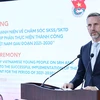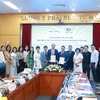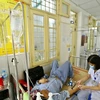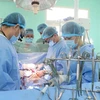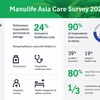Adolescent pregnancy is an increasing problem among girls in the world and Vietnam as well, which will lead to serious consequences affecting the rest of their lives.
The United Nations Population Fund (UNFPA) reports that about 16 million girls aged 15-19 give birth each year, 90 percent of whom are married.
Complications in pregnancy and childbirth continue to be the leading cause of death among girls in this age bracket in low and middle-income countries. In 2008, there were an estimated three million unsafe abortions in developing countries among girls in the age group.
Around one in three young women aged 20-24 worldwide (approximately 70 million) were married before they reached the age of 18, UNFPA said.
In Vietnam, the overall adolescent birthrate in 2011 was 46 per 1000. This rate was found to be higher among groups with ethnic minority backgrounds and lower levels of education and living standards in northern midland mountainous and rural regions.
The rate is higher than many countries in Asia, which is attributable to child marriage, premarital sex and shortage of reproductive healthcare services, thorough knowledge and official statistics on adolescent pregnancy, abortion and childbirth.
According to the Survey Assessment of Vietnamese Youth Round 2 in 2009, about 44 percent of young people aged 14-25 condoned premarital sex.
Estimates suggest that teenage abortions account for 20 percent of the total abortion rate in Vietnam. One-third of young people interviewed reported that it was not easy to access sexual reproductive health services, especially in rural and ethnic minority areas.
Deputy Minister of Health Nguyen Viet Tien said that there are over 500 million girls in developing countries today. They face tremendous challenges – often married at a very young age, become pregnant before their bodies are ready, taken out of school early, and vulnerable to violence.
UNFPA said premature births, low birth weight, stillbirths and neonatal mortality are associated with adolescent mothers. Children born to teens are more likely to die than those born to women in their twenties.
The risk of maternal death is twice as high among girls aged 15-19, and four times as high among girls under the age of 15, compared with those giving birth over the age of 20. Teenage mothers are also three times more likely to develop anaemia.
UNFPA Representative in Vietnam Arthur Erken said that adolescent pregnancies are not just a health issue but a developmental issue, deeply rooted in poverty, gender inequality, violence, child and forced marriages, power imbalances between adolescent girls and their male partners, lack of education and the failure of systems and institutions to protect their rights.
Nguyen Duc Vinh, Deputy Director of the Maternal and Child Health Department under the Health Ministry, said that to address the problem, the health sector needs to improve the quality of healthcare services; pay more attention to disadvantaged people such as those who are disabled, homeless and HIV-infected; and encourage adolescents to engage in sexual reproductive healthcare.
The sector also has to raise people’s awareness of reproductive health and life skills, and prioritise reproductive health and HIV/AIDS prevention in education.
UNFPA recommends Vietnam to promptly and strategically invest in education and healthcare for adolescent girls, and protect their human rights to reduce unwanted pregnancies.
In addition, it is necessary to implement a sex education programme and provide reproductive healthcare and HIV prevention services for adolescents in a tactful, confidential, unprejudiced and indiscriminating manner in line with international regulations.-VNA
The United Nations Population Fund (UNFPA) reports that about 16 million girls aged 15-19 give birth each year, 90 percent of whom are married.
Complications in pregnancy and childbirth continue to be the leading cause of death among girls in this age bracket in low and middle-income countries. In 2008, there were an estimated three million unsafe abortions in developing countries among girls in the age group.
Around one in three young women aged 20-24 worldwide (approximately 70 million) were married before they reached the age of 18, UNFPA said.
In Vietnam, the overall adolescent birthrate in 2011 was 46 per 1000. This rate was found to be higher among groups with ethnic minority backgrounds and lower levels of education and living standards in northern midland mountainous and rural regions.
The rate is higher than many countries in Asia, which is attributable to child marriage, premarital sex and shortage of reproductive healthcare services, thorough knowledge and official statistics on adolescent pregnancy, abortion and childbirth.
According to the Survey Assessment of Vietnamese Youth Round 2 in 2009, about 44 percent of young people aged 14-25 condoned premarital sex.
Estimates suggest that teenage abortions account for 20 percent of the total abortion rate in Vietnam. One-third of young people interviewed reported that it was not easy to access sexual reproductive health services, especially in rural and ethnic minority areas.
Deputy Minister of Health Nguyen Viet Tien said that there are over 500 million girls in developing countries today. They face tremendous challenges – often married at a very young age, become pregnant before their bodies are ready, taken out of school early, and vulnerable to violence.
UNFPA said premature births, low birth weight, stillbirths and neonatal mortality are associated with adolescent mothers. Children born to teens are more likely to die than those born to women in their twenties.
The risk of maternal death is twice as high among girls aged 15-19, and four times as high among girls under the age of 15, compared with those giving birth over the age of 20. Teenage mothers are also three times more likely to develop anaemia.
UNFPA Representative in Vietnam Arthur Erken said that adolescent pregnancies are not just a health issue but a developmental issue, deeply rooted in poverty, gender inequality, violence, child and forced marriages, power imbalances between adolescent girls and their male partners, lack of education and the failure of systems and institutions to protect their rights.
Nguyen Duc Vinh, Deputy Director of the Maternal and Child Health Department under the Health Ministry, said that to address the problem, the health sector needs to improve the quality of healthcare services; pay more attention to disadvantaged people such as those who are disabled, homeless and HIV-infected; and encourage adolescents to engage in sexual reproductive healthcare.
The sector also has to raise people’s awareness of reproductive health and life skills, and prioritise reproductive health and HIV/AIDS prevention in education.
UNFPA recommends Vietnam to promptly and strategically invest in education and healthcare for adolescent girls, and protect their human rights to reduce unwanted pregnancies.
In addition, it is necessary to implement a sex education programme and provide reproductive healthcare and HIV prevention services for adolescents in a tactful, confidential, unprejudiced and indiscriminating manner in line with international regulations.-VNA
